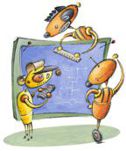DATE: Friday, December 19, 2003
TIME: Noon - 1 pm
PLACE: Wean Hall 7220
SPEAKER:
Alexander G. Fraser
Fraser
Research
TITLE:
A Packet Switch to Serve One Million Households
ABSTRACT:
A topdown study of a network for 100 million households suggests a much
simpler network topology than is presently evolving for the Internet.
Just as Federal Express discovered that computer networks and air transport
enable a more efficient centralized architecture for package delivery,
so it is apparent that fiber and the practicality of very high capacity
switches point the way to a more efficient communications infrastructure.
The question until now has been whether switches of sufficient capacity
can be constructed. This talk seeks to show that indeed they can.
Clos and Benes developed the principles which enabled large telephone switches to be made from many small switches. In recent years the study of large packet switches has found inspiration in the work of Clos and Benes even though their analytic results do not apply in a packet switched world. The problem is that bad traffic patterns cause points of severe congestion and it is hard to manage large and diverse traffic flows without triggering significant side-effects, like loss of proper sequence in the delivered data.
Quite by accident an organizing principle for large switching networks
has been found. Simulation results confirm the possibilities. In this
talk the underlying principle will be explained and there will be discussion
of simulation results for a machine to serve 256,000 homes. Simple calculations
lead to the
belief that switches with capacity in excess of 1 Pb/sec are practical.
BIO:
Alexander G. Fraser, known as "Sandy", established Fraser Research,
Inc. after his retirement from AT&T. As Vice President for Research,
he founded AT&T Labs Research in 1996 when AT&T split off its
equipment manufacturing business into Lucent Technologies. He was appointed
AT&T Chief Scientist in 1998. He is a co-PI of the NSF sponsored 100x100
project.
Fraser arrived at AT&T Bell Laboratories in 1969 and while there invented the DataKit Virtual Circuit Switch and the Spider ring network, both of which are cell-based networks that anticipated the development of Asynchronous Transfer Mode (ATM). He created the UNIX Circuit Design Aids System which automatically produced wire-wrap circuit boards from schematic circuit diagrams. With S.C. Johnson, he developed a technique for computer instruction set optimization using a portable compiler and this led to the design of a reduced instruction set machine. With W.T. Marshall and G.G. Riddle, he invented the Universal Receiver Protocol. With C.R. Kalmanek and R.C. Restrick, he created INCON, a cell-based network which operated at 2 Mb/s on home telephone wire. In 1982 he became the director of the Computing Science Research Center and five years later, became the Executive Director responsible for the information sciences including mathematics, signal processing, computing and software production. In 1994 Fraser became Associate Vice President for Information Science Research where he focused on research initiatives including electronic commerce for digital audio, billing, broadband access and home networks.
Before joining Bell Labs, Fraser was Assistant Director of Research at Cambridge University where he wrote the file system for the Atlas 2 computer, England's first time-sharing system, and developed file back-up and privacy mechanisms for that system. Earlier work includes a language and compiler for commercial data processing written for the Ferranti Orion computer.
Fraser has a B.Sc. degree in Aeronautical Engineering from Bristol University and received his Ph.D. in Computing Science from Cambridge University. He is an IEEE Fellow, a member of ACM and was a Fellow and council member of the British Computer Society. He has served on various committees for these societies and for the National Research Council.
In 2001 Dr. Fraser received IEEE's Richard W. Hamming Medal "for pioneering contributions to the architecture of communication networks through the development of virtual circuit switching technology". In 2000 Fraser became an AT&T Fellow "for pioneering work and sustained leadership in the design and creation of large scale networks and their applications." In 1989 he received the Koji Kobayashi Computers and Communications Award "for contributions to computer communications and the invention of virtual-circuit switching". The 1992 Sigcomm Award was given to him for outstanding technical achievements in the fields of data and computer communications.
He has served on advisory boards for Columbia University, Rutgers University and the University of Texas. He has 16 patents and 30 publications.
Host:
Hui Zhang
SDI / LCS Seminar Questions?
Karen Lindenfelser, 86716, or visit www.pdl.cmu.edu/SDI/
